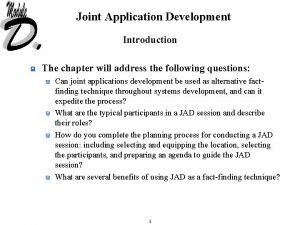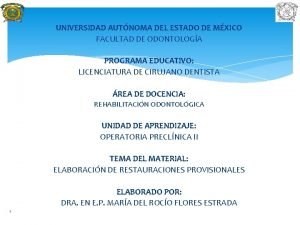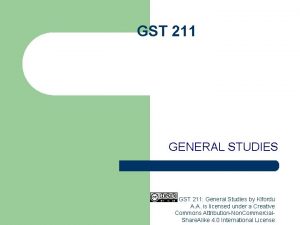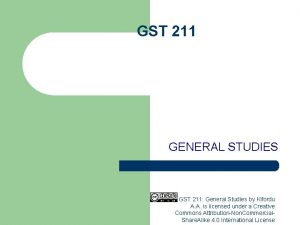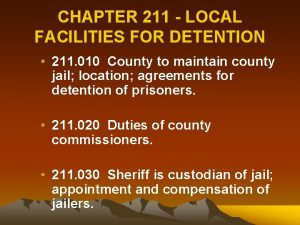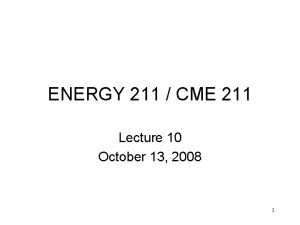POLI 211 Introduction to Development Studies Session 5

























- Slides: 25

POLI 211 Introduction to Development Studies Session 5 RURAL DEVELOPMENT Lecturer: Dr. Maame Adwoa A. Gyekye-Jandoh Contact Information: mgyekyej@yahoo. com College of Education School of Continuing and Distance Education 2014/2015 – 2016/2017

Session Overview – Overview This session brings us to a study and analysis of some real life issues of development. It introduces the varied and important issues regarding rural development. Rural development is increasingly seen in Development Studies as very important and necessary for the overall development of a country. Thus, this session will discuss agricultural progress and rural development, and the types of agriculture common in developing countries. Slide 2

Session Outline The key topics to be covered in this session are as follows: • Topic One: The Imperative of Agricultural Progress and Rural Development • Topic Two: Agricultural Stagnation and Growth Since 1950 • Topic Three: The Nature of Agricultural Systems of Developing Nations Slide 3

Reading List • Todaro, Michael. 2000. Economic Development. England: Pearson Education Limited. • Michael Todaro and Stephen Smith (2012). “Agricultural Transformation and Rural Development”. • Major newspapers and news magazines both locally and internationally, regarding rural and agricultural development. Slide 4

Topic One THE IMPERATIVE OF AGRICULTURAL PROGRESS AND RURAL DEVELOPMENT Slide 5

The Imperative of Agricultural Progress and Rural Development • Today, development economists have come to realize that rather than a passive, supportive role in economic development, the agricultural sector and the rural economy must play an indispensable role in overall national development (Todaro 2000). • Without such integrated rural development, development economists point out that industrial growth would be stunted, or even if it succeeded, it would create an imbalance in the economy, making worse widespread poverty, inequality, and unemployment. • Michael Todaro (2000), for example, argues that if sustainable development is to take place, it will have to begin in the rural areas in general and particularly in the agricultural sector. He continues to argue that core problems of widespread poverty, growing inequality, rapid population growth, and rising unemployment, tend to originate in the stagnation and decline of economic life in the rural areas of developing nations. Slide 6

An Agricultural and Employment-Based Strategy of Economic Development • In Africa, three quarters of the population live in rural areas. Of greater importance is that the vast majority (almost 70%) of the poorest people in the world live in rural areas and engage primarily in subsistence agriculture. More than 800 million of these people do not have enough food to meet their basic nutritional needs. • An Agricultural and Employment-Based Strategy of Economic Development: note that an emphasis is placed here on • 1. the importance of increasing agricultural output or production through price increases for their produce which will encourage farmers, through a use of better technology for farming, • 2. the importance of increasing jobs even in the urban areas to create more purchasing power for those in the urban areas and more demand for agricultural produce from the rural areas. Slide 7

An Agricultural and Employment-Based Strategy of Economic Development • 3. The farmers in the rural areas must support other rural activities that are not agricultural, such as banking, or weaving, for example, even as these development activities also positively impact the lives of the people and farmers. • Thus, Todaro (2000; 2012) makes the argument that an agricultural and employment-based strategy of economic development will contribute toward the development of the less developed nations, especially those in Africa. Slide 8

Sample Questions • What are three important requirements for an agriculturebased strategy of economic development? • Give two reasons why development scholars increasingly argue that agricultural progress and rural development are needed for the overall development of developing countries, especially in Africa. Slide 9

AGRICULTURAL STAGNATION AND GROWTH SINCE 1950 Topic Two Slide 10

Agricultural Stagnation and Growth since 1950 • It is important to note that agricultural stagnation in the 1950 s did not augur well for many an African country and other developing nations. In Africa, since 1950, the share of agricultural output in total Gross National Product (GNP) declined. • You must note that while the agricultural sector accounts for most employment in developing countries, it accounts for a much lower share of output or goods produced (Todaro 2000). It is interesting to note that agricultural production does not make up more than 30% of the total national product in any developing region. Slide 11

Agricultural Stagnation and Growth Since 1950 • In the 1960 s, there unfortunately was complete stagnation of the agricultural sectors in many developing and African countries. Between 1950 and 1970, per capita food production as well as per capita agricultural production (not only food but also products like cotton, wool, sisal, rubber) increased by less than one percent each year in the developing world as a whole. • On the whole, people were little or no better off in terms of getting access to food by the end of the 1960 s decade than they were at the beginning of that decade. The situation saw some improvement in the 1970 s as developing countries began to focus more attention on increasing agricultural productivity. Because of this focus, between 1970 and 1980, per capita food production grew at an annual rate of 0. 5%. • As Todaro (2000) has highlighted, these positive developments continued and got better into the 1990 s, with much of the increase occurring toward the end of the 1990 s. Slide 12

Agricultural Stagnation in Africa • In contrast to Latin America and Asia, per capita food production in Africa has declined steadily since the 1970 s. Between 1970 and 1994, Todaro (2000) argues that Africa as a whole became even more underdeveloped. • Unfortunately for the African region, the Food and Agriculture Organization (FAO) has estimated that of the 750 million people in Africa, more than 270 million suffer from some of malnutrition associated with insufficient supply of food. • The food crisis became much more widespread between 1982 and 1984, 1987 and 1988, 1991 and 1992, and 1993 and 1994, affecting more than 22 nations threatened by severe famine, including Ethiopia, Senegal, Cape Verde, Zambia, Tanzania, Malawi, Uganda, Botswana, Mozambique, Zimbabwe, and Angola (Todaro 2000). Slide 13

Reasons for the Decline in African Agricultural Production • Reasons for the decline in agricultural production in Africa since the 1950 s • I 1. insufficient and inappropriate innovation • 2. cultivation of sensitive and marginal lands • 3. severe deforestation and erosion • 4. civil wars that are often and unpredictable, and • 5. misguided pricing and marketing policies which rather reduced incentives for farmers. • All of the above were made worse by the fact that Africa has the highest rate of population growth in the world (Todaro 2000). Slide 14

Reasons for the Decline in African Agricultural Production • One major reason for the relatively poor performance of agriculture in developing countries is the fact that developing country governments’ neglect of agriculture and bias toward urban industrialization can largely be traced to the misplaced emphasis on rapid industrialization through import substitution and overvaluation of exchange rates that characterized development thinking and strategy in the early postwar years (1950 s and 1960 s). • Note that one significant result of this rural neglect and corresponding emphasis on urban growth has been the massive migration of peasants from the rural areas to the cities and urban areas of developing nations. This has not augured well for overall national development. Slide 15

Questions to Consider • Questions to consider: • Discuss at least three reasons why agricultural production declined steadily in Africa beginning in the 1950 s. • Which of these reasons, in your view, was the most important reason for the decline in agricultural production in Africa, , and why? Slide 16

Topic Three THE NATURE OF AGRICULTURAL SYSTEMS OF DEVELOPING NATIONS Slide 17

The Nature of Agricultural Systems of Developing Nations • This third topic seeks to explain the nature or structure of agricultural systems in developing nations, contrasting them briefly with agricultural systems in developed countries. • There are two broad kinds of farming or agriculture in the world today. • 1. the highly efficient agriculture of the developed countries, where great productive capacity and high output per worker enables a very small number of farmers to feed entire nations. • 2. the other type of agriculture involves the inefficient and lowproductivity agriculture of developing nations, where, in many cases, the agricultural sector can barely sustain the farm population, let alone the ever-increasing population, even at a minimum level subsistence. Slide 18

The Nature of Agricultural Systems of Developing Nations • Growth in agricultural output in the developed countries accelerated after the First World War and especially after the Second World War, so that fewer farmers are able to produce more food. The United States is a good example: in 1998, only 2% of the entire working population was engaged in agriculture, compared with more than 70% of its workforce in the early 19 th century (early 1800 s). • In developing countries, we see an entirely different picture. Here, agricultural production methods have changed quite slowly over time, mainly due to the persistence of peasant agriculture (has high risks and uncertain returns). Slide 19

Types of Developing Nations’ Agriculture • In developing countries, a common characteristic of agriculture, whether in Latin America, Asia, or Africa, is the position of the family farm as the basic unit of production. Farmers in these countries also show many of the same economic behavior patterns. • 1. The most prevalent type of agriculture in developing countries is peasant or subsistence agriculture (farming) on small plots of land. Here, food is grown for consumption or subsistence of the family mostly, although some may be sold or traded in local markets. A few staple crops (including wheat, rice, corn, sorghum) are the chief sources of food intake. Productivity and output are low, and only the simplest tools and traditional methods are used. Slide 20

Types of Developing Nations’ Agriculture • 2. The second type of agriculture is diversified or mixed farming, where part of the produce is grown for consumption at home and part for sale on the market. Diversified farming therefore represents a logical intermediate stage in the transformation from subsistence to specialized production. • In addition to the staple crops, new cash crops such as fruits, vegetables, coffee, tea, as well as animal farming, for example, are introduced. • Diversified farming can also minimize the impact of staple crop failure and provide income security which was previously unavailable. Slide 21

Types of Developing Nations’ Agriculture • 3. The third type of agriculture is commercialized farming, where the modern farm exists and is only engaged in high-productivity specialized agriculture targeted to the commercial market. This is the most common type of farming in the advanced industrialized countries. • It is usually brought about by a general rise in standards of living, technological and biological progress, and the expansion of national and international markets. Pure commercial profit, rather than the provision of food for the family with some surplus that can be sold, is the basic goal. Production is entirely for the market. Slide 22

Concluding Remarks • We may conclude that the majority of agricultural systems of developing nations are still dominated by subsistence and small-scale mixed family farms. Commercial farms are slowly on the rise in these nations, but given the population, poverty, and urban unemployment problems that beset them, the major immediate avenue by which to achieve “real peopleoriented rural development” is the improvement of small - and medium-scale farming practices that will raise farm incomes and average yields, as well as effectively absorb the underemployed rural labor. Slide 23

Conclusion of Session 5 • In this session, we have discussed the fact that agricultural and rural sector development is indeed good and beneficial for development of African and other developing nations in the world. • We have taken a historical overview of agricultural production in developing countries and particularly in Africa since the 1950 s. The period from the 1950 s through the 1980 s was characterized by decline in agricultural production in the African region. Some of the major reasons for this decline, include the lack of appropriate government attention and investment in the agricultural sector. • Finally, we have discussed the difference between the agricultural systems of developing nations and developed nations, as well as the nature of developing nations’ agriculture. We have noted the principal characteristics of three types of agriculture – subsistence, mixed, and commercial. The mixed or diversified farming, we also argued, holds out the most realistic option for accelerating rural development and agricultural production in the short to medium term. Slide 24

References • Todaro, Michael. 2000. Economic Development. England: Pearson Education Limited. • Michael Todaro and Stephen Smith (2012). “Agricultural Transformation and Rural Development”. In Economic Development. p. 416457. England: Pearson Education Limited. Slide 25
 Poli 211
Poli 211 Paradigm shift from women studies to gender studies
Paradigm shift from women studies to gender studies Advantages of joint application development
Advantages of joint application development Umass poli sci
Umass poli sci živočíchy spoločenstva polí
živočíchy spoločenstva polí Je rastlina ktorá rastie na lúke na poli burinou
Je rastlina ktorá rastie na lúke na poli burinou Rastliny rastuce na poli
Rastliny rastuce na poli Poli 112
Poli 112 Definisi kia
Definisi kia Model devíti polí čáp
Model devíti polí čáp Pohyby telies v radiálnom gravitačnom poli zeme
Pohyby telies v radiálnom gravitačnom poli zeme častica s nábojom v magnetickom poli
častica s nábojom v magnetickom poli Introduction to medical terminology chapter 1 answer key
Introduction to medical terminology chapter 1 answer key Urologie roermond
Urologie roermond Rastliny rastuce na poli
Rastliny rastuce na poli Spoločenstvo polí
Spoločenstvo polí Poli etil metacrilato
Poli etil metacrilato Il circolo di illuminazione passa sempre dai poli
Il circolo di illuminazione passa sempre dai poli Pohádka o budce text
Pohádka o budce text Goudvispoli
Goudvispoli Efkaristo meaning
Efkaristo meaning Poli buscador
Poli buscador Politong
Politong Raza poli
Raza poli Magda poli
Magda poli Estagios poli usp
Estagios poli usp


